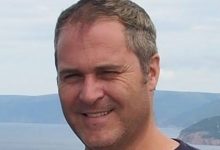Cluttered little barn at the centre of a 350-million-year-old fossil mystery
Inside a quirky barn near Hantsport, N.S., 350-million-year-old fossils are displayed on a dusty piano, in crowded china cabinets and on a child’s red wagon.
It’s a seemingly haphazard museum with unexpected importance: the adjacent beach is one of only two places in the world where the oldest fossilized land animals on Earth can be found.
Researchers from Harvard University, Cambridge University and the New Mexico Museum of Natural History and Science are drawn to the picturesque shoreline to examine fossils that cast new light on a little-understood time period.
Still, the museum that houses the unique treasures is operating on a shoestring budget.
A true labour of love, Chris Mansky and his wife, Sonja Wood, have run the Blue Beach Fossil Museum for 19 years, mostly on visitor donations. They want a new centre to be built.
“The Blue Beach deposit is incredibly rich and well-preserved,” said Mansky, museum curator and self-taught fossil researcher.
“There is no fossil collection like it. Every year, new fossils are coming, and we can count on making rare finds in the future.”
The fossils found at Blue Beach offer a glimpse into how fish evolved, creeping out of the water to become four-legged land creatures known as tetrapods. It’s the age that followed a mass extinction that closed out the Devonian period.
The site is located at the Bay of Fundy’s Minas Basin, which has the highest tides in the world. The sea has eroded the cliffs on the shoreline, uncovering 350-million-year-old fossils.
As Mansky puts it: “Nature does the digging here.”
But just as quickly as the fossils are revealed, the powerful tides can sweep them away, so frequently scouring for specimens is important.
Mansky — a self-proclaimed “rock hound” — has spent more than two decades combing the shoreline, bending down amidst shale, sandstone, siltstone and mudstone to pick up scientifically important relics.
It was the only place in the world that peered into the so-called Romer’s gap — a roughly 20-million-year blank in the tetrapod fossil record — until 2015, when similar sites were developed in Scotland.
About 10,000 fossil bones are stacked high in 800 cardboard boxes on a staircase, in the upper loft and in the elevator shaft inside the mom-and-pop museum. It’s only a small part of the Blue Beach collection — the rest is stored in outbuildings.
Despite the apparent chaos, each fossil has been catalogued. But it can take Mansky weeks or even months to locate a fossil not frequently requested for examination by the world-renowned paleontologists who conduct research using the fossils.
“Storage has always been an issue,” said Mansky, adding that with so many fossils found on a daily basis, many duplicates simply get tossed back onto the beach.
“One of my colleagues commented that this reminded him of a time they had to go to Kazakhstan to study the fossils…. The same fossils found here would be in steel cabinets in the [Smithsonian Institution] and they would have to be handled with white gloves.”
The couple have a $2-million plan in place to build a new centre on the two-hectare site, which is visited by thousands of people a year, despite virtually zero advertising.
They say they have all the necessary building, zoning and environmental approvals, but they need big donations to kickstart the project.
“We’re still at ground zero after 19 years and we’ve put a lot of effort in,” said Wood, noting she almost lost the property a few times over the years.
“This is a world-class site, and if we lose it, the project will be gone.”
Discoveries have been made and many scholarly papers have been written using research conducted at Blue Beach.
“Blue Beach is actually rewriting textbook’s understanding of how we went from the age of the fish to the age of life on land,” said Mansky.
In 2015, a new species was discovered and was named after Mansky.
Research by Jason Anderson, a vertebrate paleontologist at the University of Calgary, shows the Avonichthys manskyi’s lineage appears to be a survivor of the Devonian extinction, which contradicts the notion that the extinction wiped out that group.
Anderson said the site is extremely valuable to the scientific community. He said Blue Beach is paramount in studying a time period that in the past, has only been hypothesized.
“The fossils from Blue Beach and the fossils from the Borderlands region of Scotland are enabling us to say what might have been going on within this time period, within this particular region of the world,” said Anderson, who has been conducting research at Blue Beach for 17 years.
“The fossils belong to the people of Nova Scotia, so the province eventually is going to have to find a permanent solution.”
You only have to walk a few steps to find fossils on Blue Beach.
Under an overcast sky, Mansky takes one knee and picks up a flat rock. He points to black speckles on its surface and notes they are fossilized plant material.
“Typically I would zigzag along and try to locate those important pieces that contain something before the tides wash them out to sea,” said Mansky, brushing sweat from his brow as waves inched up the rocky beach.
He said as visitors look around inside the museum at its hand-painted signs and exhibit labels printed on paper the size of recipe cards, “they wonder why more isn’t being done for this place.”
“I can say that my wife and I are doing all we can,” he said. “But two people do not have the ability to do this alone.”








Redes Sociais - Comentários